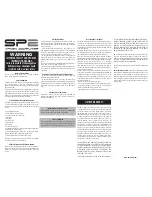
If a probe tip is attached to a probe but not soldered to anything, the inputs will be open which effectively makes the source
resistance look much larger than the 25 kΩ attenuator resistors. As a result, the offset voltage control is no longer calibrated
and will have 2X the calibrated effect on the measured probe output. This effect can be helpful in troubleshooting
connection issues with the tips. If a probe tip has been soldered to a DUT and adjusting the offset voltage causes the offset
to move 2X the adjustment, it could indicate a broken solder joint that has left the probe tip input open.
Making single ended measurements using the P77BRWSR differential probe tip
A TriMode tip provides solder connections for a DUT ground reference for both the A and B probe inputs making single-
ended measurements with a TriMode probe tip straightforward. Although the differential input mode of the probe is normally
used to make a differential signal measurement, single-ended measurements can be made using Differential Input mode
when the probe input connections and offset voltage controls are configured properly, This single-ended configuration
process is particularly important to understand when using the tip, since this variable-spacing Browser tip operates only in
Differential Input mode. Differential Input mode provides a measurement of the difference (A – B) between the A and B input
signals. If the probe tip B input is connected to a DUT ground, the resulting Differential Input mode measurement (A – 0 V)
results in a display of the single-ended A input signal response.
When making differential signal measurements, the P77BRWSR Offset Voltage control is normally set to the Common-
mode (CM) Tracking mode. With CM tracking mode active, the A and B input signals are monitored and the Offset A and
Offset B settings are both adjusted to match the DC common-mode voltage of the A and B input signals [(A + B)/2]. The
differential Offset voltage should be set manually to the center of the signal voltage swing. The common mode offset should
be set to 1/4 of the signal swing. For a +5 V CMOS logic signal; for example, the differential offset voltage should be set to
+2.5 V and the common mode offset should be set +1.25V. The A signal input voltage should then range from +5 V to 0 V,
which is within the 6 Vp-p dynamic range of the Browser tip as long as the offset voltage is set near the center of its
expected voltage swing. These offset settings maximize the dynamic range of single ended measurements for the
differential browser.
Temperature compensation
The TDP7700 Series probes employ temperature compensation to optimize measurement accuracy.
Active tip measurement configuration
In many of the high-frequency signaling standards that the TDP7700 Series probes are designed for, a 50 Ω termination at
the transmitter is in parallel with another 50 Ω termination at the end of the transmission line path, effectively making a 25 Ω
signal source impedance. In this application, the solder tip or browser tip measurement configuration is designed to pick off
the transmitted signal at a location in the signal transmission path.
The input impedance for a solder tip, Z probe, varies with frequency. For a TekFlex solder tip the DC input resistance is
about 50 kΩ and decreases with frequency above about 10 MHz to about 100 Ω above 10 GHz. Refer to the graphs later in
this document for input impedance information. See page
Figure 22: Active tip measurement configuration
Skew measurements of differential signals
Differential signals are composed of two complementary single-ended signals that generally swing around a common bias
voltage. An example of an LVDS differential signal is shown in the following figure.
Theory of operation
TDP7700 Series TriMode™ Probes Technical Reference
18













































